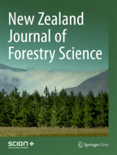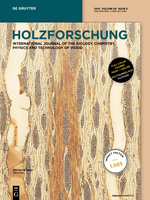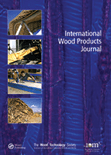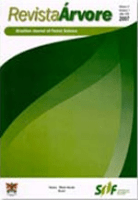
European Journal of Wood and Wood Products
Scope & Guideline
Advancing wood science for a sustainable future.
Introduction
Aims and Scopes
- Wood Material Properties and Performance:
Research that investigates the physical, mechanical, and chemical properties of various wood species and engineered wood products, aiming to improve their performance in applications. - Sustainable Wood Utilization:
Studies promoting the sustainable use of wood resources, including the development of eco-friendly wood preservatives, recycling of wood waste, and utilization of underutilized wood species. - Wood-Based Composite Materials:
Exploration of composite materials incorporating wood fibers and polymers, focusing on enhancing properties through innovative treatments and formulations. - Wood Processing Technologies:
Investigations into advanced processing techniques, such as thermal modification, adhesive technologies, and machining processes that optimize wood performance. - Wood Durability and Preservation:
Research on the durability of wood against biological and environmental factors, including studies on preservatives and treatments to enhance longevity. - Acoustic and Thermal Properties of Wood:
Examination of the acoustic and thermal insulation properties of wood and wood-based products, vital for applications in construction and furniture.
Trending and Emerging
- Biotechnology in Wood Science:
An increasing number of studies are exploring the use of biological methods for wood preservation and modification, indicating a growing interest in eco-friendly and sustainable approaches. - Advanced Composite Materials:
There is a notable trend towards developing advanced composite materials that incorporate wood fibers with polymers and other materials, aimed at enhancing performance and sustainability. - Smart Wood Products and IoT Integration:
Emerging research focuses on integrating smart technologies into wood products, such as sensors and IoT devices, to monitor conditions and improve functionality. - Machine Learning and Data Analytics in Wood Science:
The application of machine learning and data analytics for predicting wood properties and optimizing manufacturing processes is gaining traction, reflecting the industry's shift towards data-driven methodologies. - Circular Economy Practices in Wood Utilization:
Research on the circular economy and sustainable practices in wood utilization is becoming increasingly relevant, emphasizing waste reduction and resource efficiency in the wood industry.
Declining or Waning
- Traditional Wood Finishing Techniques:
Research related to conventional wood finishing methods has decreased, possibly due to a shift towards more sustainable and innovative finishing materials and techniques. - Basic Wood Anatomy and Morphology:
Papers focusing on fundamental aspects of wood anatomy and morphology have become less prominent, as the field moves towards more applied research with practical implications. - Non-Destructive Testing Methods:
Interest in traditional non-destructive testing methods for wood evaluation has waned, likely due to advancements in more sophisticated and efficient evaluation techniques.
Similar Journals

TREES-STRUCTURE AND FUNCTION
Pioneering insights into the structure and function of trees.TREES - STRUCTURE AND FUNCTION, published by Springer Heidelberg, is a leading journal dedicated to advancing the scientific understanding of tree biology through rigorous research and interdisciplinary approaches. With an impressive impact factor reflecting its high visibility in the scholarly community, this journal specializes in various aspects of tree ecology, physiology, and structure, making it a vital resource for researchers, professionals, and students engaged in forestry and environmental sciences. The journal holds notable rankings, placing it in the top quartiles of several categories, including Q1 in Forestry and Q2 in Ecology as of 2023, underscoring its relevance and influence in the field. Although it is not an open-access journal, TREES strives to disseminate critically important findings that contribute to our understanding of global forest ecosystems and their role in climate change mitigation. With a publication history spanning from 1986 to 2024, this journal continues to shape the future of tree research, providing a platform for innovative studies that inform policy, conservation, and sustainable practices.

NEW ZEALAND JOURNAL OF FORESTRY SCIENCE
Empowering Knowledge for a Greener TomorrowNEW ZEALAND JOURNAL OF FORESTRY SCIENCE (ISSN: 0048-0134; E-ISSN: 1179-5395), published by SCION, stands as a pivotal resource for researchers, professionals, and students dedicated to the fields of forestry, ecology, and plant sciences. With a strong commitment to open access since 2013, the journal promotes the dissemination of high-quality research and innovative practices within these disciplines, thereby fostering a greater understanding of the natural environment. The journal has achieved commendable rankings, being placed in the Q2 category in Ecology, Forestry, and Plant Science, reflecting its significant contribution to advancing knowledge and best practices in these areas. Based in Switzerland and published by SCION, a trusted name in forest research, the journal plays an integral role in shaping the dialogue around sustainable forest management and ecological conservation. As such, it serves as an essential platform for scholarly discourse and a valuable resource for anyone engaged in forestry and environmental studies.

WOOD RESEARCH
Fostering Global Collaboration in Wood ResearchWOOD RESEARCH is a premier academic journal published by the SLOVAK FOREST PRODUCTS RESEARCH INSTITUTE, dedicated to advancing knowledge in the fields of forestry and material science. With an ISSN of 1336-4561, this journal serves as a vital resource for researchers and professionals seeking to explore innovative research, advancements in wood technology, and sustainable practices related to forest products. Recognized for its quality, WOOD RESEARCH holds a Q2 ranking in the field of Forestry and a Q3 ranking in Materials Science according to the latest metrics, indicating a robust contribution to these disciplines. The journal is committed to open access options, ensuring that findings are accessible to a global audience, thereby fostering collaboration and knowledge sharing. Established in 2003 and operating through to 2024, it continues to play a significant role in shaping the future of wood research, offering insights that are essential for students, academics, and industry leaders alike. For detailed submissions and research discussions, the journal can be accessed through its dedicated platform, contributing to an enriched academic dialogue in Slovakia and beyond.

HOLZFORSCHUNG
Innovating biomaterials through wood research.HOLZFORSCHUNG is a distinguished journal in the field of biomaterials, published by WALTER DE GRUYTER GMBH and based in Berlin, Germany. With an ISSN of 0018-3830 and an E-ISSN of 1437-434X, this journal has been a key player in advancing the understanding of wood research and its applications since its inception in 1947. As of 2023, it holds a Q3 ranking in the biomaterials category, positioned at #77 out of 137 in Scopus, reflecting its growing reputation within the academic community. Although it does not currently offer open access, HOLZFORSCHUNG aims to bridge the gap between theoretical research and practical applications, providing valuable insights for researchers, professionals, and students alike. With a focus on innovative studies and contributions to the understanding of wood as a biomaterial, it remains integral to the discourse in materials science.

International Wood Products Journal
Pioneering Knowledge for a Greener FutureInternational Wood Products Journal is a premier academic publication dedicated to advancing knowledge in the fields of forestry and materials science. Published by SAGE Publications Inc, this journal serves as a critical forum for researchers and professionals alike, focusing on innovative developments and sustainable practices related to wood and wood products. With an impressive impact factor that places it in the Q2 category for forestry and Q3 for materials science in 2023, it showcases high-quality research that influences policy and practice. Covering a wide scope from 2010 to 2024, the journal offers insightful articles and reviews that highlight the latest findings and technological advancements in wood products. Notably indexed in Scopus, it ranks 69th out of 174 in Forestry and 296th out of 463 in General Materials Science, attesting to its relevance and contribution to these fields. Researchers and students are encouraged to explore this journal for cutting-edge information and collaborative opportunities within the international wood products community.

WOOD SCIENCE AND TECHNOLOGY
Transforming Wood Science for a Sustainable FutureWOOD SCIENCE AND TECHNOLOGY, published by SPRINGER, is a premier academic journal dedicated to the multidisciplinary study of wood and its applications. With a rich history spanning since its inception in 1967 and continuing through 2024, this journal plays a vital role in advancing our understanding of forestry, industrial and manufacturing engineering, and materials science. It enjoys an impressive categorization in the 2023 rankings, securing a Q1 status in Forestry and notable Q2 rankings in Industrial and Manufacturing Engineering, Materials Science, and Plant Science. Researchers and professionals benefit from its rigorous peer-reviewed articles, making substantial contributions to the field. The journal is actively indexed, ensuring high visibility and access to its content, which is essential for anyone looking to stay at the forefront of wood science research. The current impact factors and rankings affirm its significance, making it a critical resource for academics seeking to foster innovation and collaboration in wood technology and related disciplines.

Floresta e Ambiente
Championing open access to vital environmental research.Floresta e Ambiente is a pioneering open-access journal dedicated to advancing knowledge in forestry and environmental science, published by the Federal Rural University of Rio de Janeiro's Institute of Forests. Since its inception in 2012, this journal has emerged as a crucial platform for researchers, professionals, and students to disseminate innovative findings and foster discussions on sustainable forest management, conservation practices, and the ecological significance of forests in Brazil and beyond. With an impressive impact factor and a commendable ranking in the SCOPUS database, positioned in the 49th percentile of the Agricultural and Biological Sciences category, Floresta e Ambiente actively supports the dissemination of high-quality research while contributing to the global discourse on forestry. As an open access journal since 2013, it ensures that valuable knowledge is readily available to all, enhancing collaboration and engagement within the scientific community.

Drvna Industrija
Advancing Knowledge in Forestry and Wood SciencesDrvna Industrija, a peer-reviewed journal published by the Zagreb University, Faculty of Forestry, serves as a cornerstone for research in the field of forestry and wood industry sciences. Established in 1980 and with a commitment to open access since 2006, this journal allows for a broad and unrestricted dissemination of knowledge, featuring original articles, reviews, and case studies that reflect the latest advancements in forestry practices and wood industry technologies. With its ISSN 0012-6772 and E-ISSN 1847-1153, Drvna Industrija is indexed in Scopus, holding a respectable Q3 quartile ranking in the forestry category, which places it in the top half of the field. As of 2023, it ranks 85th out of 174 in Agricultural and Biological Sciences with a 51st percentile, highlighting its relevance and impact in contemporary research. The journal's dedication to promoting innovative practices and fostering academic excellence continues to engage researchers, professionals, and students in Croatia and around the world, contributing significantly to the discourse on sustainable forest management and utilization of wood products.

MOKUZAI GAKKAISHI
Pioneering Research in Wood Materials and ProcessingMOKUZAI GAKKAISHI, a prestigious journal published by the Japan Wood Research Society, serves as a critical resource for scholars and practitioners in the field of wood science and technology. With an ISSN of 0021-4795 and an E-ISSN of 1880-7577, this journal has been a pivotal platform since its inception in 1949, focusing on a broad spectrum of topics including wood materials, wood processing, and sustainable forestry practices. Although it does not currently offer open access options, its rigorous peer-review process ensures high-quality research dissemination. As researchers and professionals delve into the complexities of wood science, MOKUZAI GAKKAISHI stands out as an essential academic journal that informs, engages, and inspires innovative solutions in wood utilization and conservation efforts. The journal's historical significance and ongoing contributions make it a staple reference for anyone looking to advance their understanding of wood-related research and applications.

REVISTA ARVORE
Nurturing Innovation in Ecological ConservationREVISTA ARVORE is a distinguished, peer-reviewed journal in the field of Forestry, published by Universidade Federal de Viçosa in Brazil. Renowned for its commitment to open access since 2002, this journal facilitates the dissemination of innovative research and knowledge to a global audience, encompassing topics from sustainable forest management to ecological conservation. With an impact factor reflective of its engagement in the community and a current Scopus ranking that places it in the 28th percentile among journals in Agricultural and Biological Sciences, it provides a vital platform for both emerging and established scholars. The journal is indexed under ISSN 0100-6762 and E-ISSN 1806-9088, making it accessible to a wide readership. As it converges its publication years from 2006 to 2024, REVISTA ARVORE aims to contribute significantly to the advancement of forestry science and practices, thereby encouraging environmental sustainability and innovation within the field.